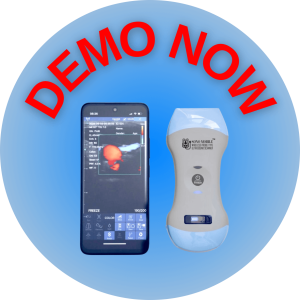Mobile ultrasound technology offers significant benefits in veterinary medicine, enhancing diagnostic capabilities and improving patient care in various animal species. Here’s how it can be beneficial:
- Diagnostic Imaging: Mobile ultrasound provides veterinarians with real-time imaging of internal organs, allowing for the detection and characterization of abnormalities such as masses, cysts, and fluid accumulations.
- Reproductive Health: Ultrasound is widely used in reproductive medicine for assessing pregnancy, fetal viability, and fetal development in It helps in confirming pregnancies, estimating litter size, and monitoring fetal growth and well-being.
- Musculoskeletal Assessment: Ultrasound aids in the evaluation of musculoskeletal conditions such as tendon and ligament injuries, joint effusions, and muscle abnormalities in animals, guiding treatment decisions and rehabilitation plans.
- Abdominal Evaluation: It allows for detailed assessment of abdominal organs including the liver, spleen, kidneys, and gastrointestinal tract, aiding in the diagnosis of diseases such as liver or kidney failure, gastrointestinal obstructions, or urinary tract disorders.
- Cardiac Imaging: Mobile ultrasound can be used to assess cardiac function, visualize cardiac structures, and detect abnormalities such as congenital heart defects or cardiomyopathies in veterinary patients.
- Guidance for Procedures: Ultrasound guidance improves the accuracy and safety of procedures such as biopsies, aspirations, and fluid drainage in animals, reducing the risk of complications and increasing diagnostic yield.
- Emergency Medicine: In emergency situations, mobile ultrasound provides rapid assessment of trauma, internal bleeding, or other critical conditions, allowing for immediate triage and treatment decisions in veterinary patients.
- Ophthalmic Evaluation: Ultrasound can be used for ophthalmic examinations in animals to assess the globe, detect intraocular masses or abnormalities, and evaluate structures such as the lens or retina.
- Rehabilitation and Physical Therapy: It aids in monitoring the progress of rehabilitation programs and assessing the response to physical therapy interventions in animals recovering from injuries or surgeries.
- Exotic Animal Medicine: Mobile ultrasound is valuable in exotic animal medicine for evaluating internal organs and structures in species such as birds, reptiles, and small mammals, where traditional imaging modalities may be challenging or impractical.
- Remote and Field Medicine: The portability of mobile ultrasound allows veterinarians to perform imaging studies in remote locations, on farms, or in the field, facilitating diagnosis and treatment of animals in various settings.
- Preventive Medicine: Ultrasound can be used as a screening tool for early detection of diseases or abnormalities in apparently healthy animals, allowing for timely intervention and preventive care.
Overall, mobile ultrasound technology enhances veterinary medicine by providing veterinarians with a versatile, non-invasive imaging tool that improves diagnostic accuracy, guides treatment decisions, and enhances patient care across a wide range of animal species.



